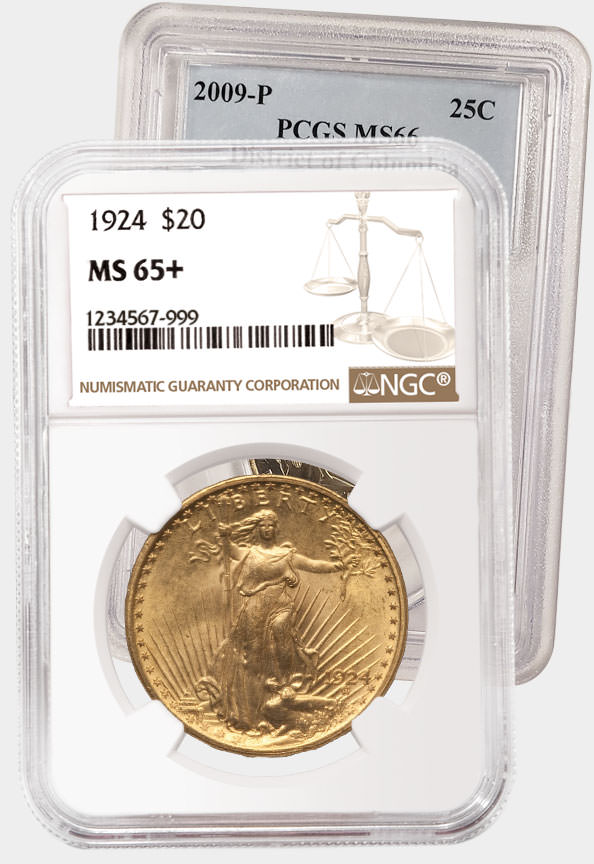Learn Grading: What Is a Mint Error? — Part 4
Posted on 21/01/2020
Every year, mints for major countries produce billions of coins. Despite sophisticated technology and comprehensive quality control efforts, some mistakes are made. Coins with mistakes are called “mint errors” and are among the most popular segments of numismatics.
This series of articles has explored mint errors and their causes. Part 1 focused on the mint errors primarily caused by the dies used to strike the coins, while Part 2 and Part 3 looked at errors caused by the strike itself. Here, in Part 4, this series concludes by looking at planchet issues.
Coins are created when a pair of dies strike a planchet, imparting the design. But sometimes a wrong or faulty planchet is used. Here are some examples:
Wrong planchet: This error occurs when a correctly made planchet from one denomination is accidentally fed into a press striking another denomination. Examples are a nickel struck on a cent planchet and a cent struck on a dime planchet. The coin struck on an incorrect blank will weigh exactly what the denomination of that blank would have been. An even more dramatic wrong planchet error is a coin struck on a previously struck coin.
Transitional error: This occurs when a coin is struck on a planchet from a previous year with different metal composition. The most famous is the 1943 Lincoln Cent struck on a 1942 copper blank. Other famous examples include 1965 US coinage struck in silver instead of clad. There are also transitional errors struck on blanks intended for the next year. An example is 1964 coinage in clad instead of silver. More recently, transitional errors were discovered involving the Susan B. Anthony and Sacagawea Dollars of 1999 and 2000.
Clipped planchet: Planchets are punched from large sheets of metal. After blanks are cut from a sheet, it is moved forward before more blanks are punched out. If the sheet fails to be fed far enough ahead, the punch will overlap an already punched area, causing that planchet to have a circular "clip" of missing metal. A good way to tell if the coin is an error or simply damage that occurred outside of the mint is to look for signs of metal flow into the blank area, which indicates a genuine clip. The types include curved, straight and ragged edge.
Struck fragment: The blanking press takes the coils of metal strips and punches blanks out of it, ejecting the webbing at the other end. The webbing is cut into small scrap pieces to be melted and recycled. Occasionally, a scrap piece will be mixed with the blank planchets and struck by the dies. Struck fragments are rare in the larger denominations. These can be uniface or struck on both sides.
Lamination: Dirt and impurities in the metal of the planchet can manifest themselves as cracks and peels on the struck coin. A planchet can split if impurities are severe enough.
Missing clad layer: This error happens either when a clad layer was missing before the strike or when the layer was loose and separated from the rest of the coin after the strike. The side of the coin with the clad layer missing will be copper-colored, showing the exposed core of the coin.
Misplaced or missing center hole: Some country’s coins feature holes at the center of their planchets. Occasionally, these holes will be misplaced or missing altogether.
Missing edge lettering: This mint error has been discovered in the US Presidential Dollar series. Some of these coins inadvertently left the United States Mint without edge-lettering on them. The inscriptions “In God We Trust,” “E Pluribus Unum,” as well as the mintmark and year are absent from these coins.
 |
NGC attributes major mint errors under its Mint Error service for an additional fee. For more information about NGC Services & Fees, click here.
Related links
- Learn Grading: What Is a Mint Error? — Part 3
- Learn Grading: What Is a Mint Error? — Part 2
- Learn Grading: What Is a Mint Error? — Part 1
- Learn Grading: What Are the SP and PL Prefixes?
- Learn Grading: What is a Proof Coin?
- Learn Grading: What is an NGC Details Grade?
- Learn Grading: What Are the Plus and Star Designations?
- Learn Grading: What Are Full Bell Lines?
- Learn Grading: What Is the Full Head Designation?
- Learn Grading: What Are Full Bands and Full Torch?
- Learn Grading: What are 5FS and 6FS
- Learn Grading: What are BN, RB and RD?
- Learn Grading: Prooflike (PL) and Deep Prooflike (DPL)
- Learn Grading: Proof, Proof Cameo and Proof Ultra Cameo
Stay Informed
Want news like this delivered to your inbox once a month? Subscribe to the free NGC eNewsletter today!
















